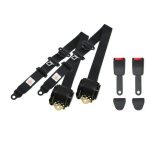Your car’s seat belt is a crucial safety feature, designed to keep you securely positioned in your seat during a collision. Modern seat belts incorporate various mechanisms to enhance protection, and one such mechanism is the seat belt pretensioner. In certain situations, the pretensioner can lock the seat belt to provide additional restraint. However, this locking mechanism might occasionally become engaged unintentionally, requiring a reset. This comprehensive guide explores when and how to reset a seat belt, highlighting safety considerations and alternative solutions.
Understanding Seat Belt Pretensioners and Accidental Locking
Seat belt pretensioners are pyrotechnic devices that tighten the seat belt webbing in a fraction of a second during a collision. This rapid tightening minimizes slack in the belt, reducing forward movement and potential injuries. Pretensioners can be triggered by a variety of factors, including:

-
Impact Sensors: Most modern cars have impact sensors that detect a collision and trigger the pretensioners.
-
Sudden Deceleration: In some cases, the seat belt pretensioners might activate due to a sudden and forceful deceleration, even if a collision doesn’t occur. This can happen during hard braking or swerving maneuvers.
-
Malfunction: While rare, there’s a possibility of a pretensioner malfunctioning and deploying unintentionally.
If the pretensioner activates, you might notice the seat belt webbing becoming noticeably tighter. In some cases, the locking mechanism might engage, preventing the seat belt from retracting or unbuckling.
When to Reset a Seat Belt: Identifying the Need
Not all situations where the seat belt feels tighter necessitate a reset. Here’s how to determine if a reset is necessary:
-
Visible Deployment: If the pretensioner has visibly deployed (a small spool or cartridge might have fired), the seat belt will likely be locked and require a reset.
-
Stuck Seat Belt: If the seat belt webbing is noticeably tighter than usual and won’t retract or unbuckle properly, it might be locked due to a pretensioner activation.
-
Warning Light: Some cars have a warning light on the dashboard that illuminates if the seat belt pretensioner system malfunctions.
Important Note: If you’re unsure whether your seat belt needs a reset, don’t attempt to force it. Consult a qualified mechanic for proper diagnosis and to avoid accidentally damaging the system.
Safety First: Important Considerations Before Resetting
Before attempting to reset your seat belt, prioritize safety with these crucial considerations:

-
Don’t Force the Seat Belt: Forcing a locked seat belt can damage the mechanism and compromise its effectiveness. If the seat belt is stuck, resist the urge to yank or pull on it excessively.
-
Consult Your Owner’s Manual: Your car’s owner’s manual is an invaluable resource for information specific to your vehicle. Refer to the manual for instructions on resetting the seat belt or any warnings regarding the pretensioner system.
-
Seek Professional Help: If you’re uncomfortable resetting the seat belt yourself, or if your car’s manual doesn’t provide clear instructions, don’t hesitate to seek assistance from a qualified mechanic. They possess the expertise and tools to diagnose the problem and reset the seat belt safely.
-
Airbag System Deactivation (if applicable): In some cars, the seat belt pretensioner system might be linked to the airbag system. If your car’s manual recommends deactivating the airbag system before resetting the seat belt, follow those instructions meticulously to avoid accidental airbag deployment.
Remember, prioritizing safety should be your top concern. If you’re unsure about any aspect of the reset process, err on the side of caution and consult a professional.
Resetting Your Seat Belt: DIY Approach (Use with Caution)
Disclaimer: The following steps are for informational purposes only and should not be a substitute for professional guidance. Attempting DIY seat belt reset at your own risk. It’s highly recommended to consult a qualified mechanic for this task, especially if your car’s manual doesn’t provide clear instructions.
Tools Required:
- Owner’s manual (specific to your car)
- Socket wrench set (optional)
Steps:
Note: Reset procedures can vary significantly depending on your car’s make and model. Always refer to your owner’s manual for specific instructions. The following steps provide a general overview:

-
Locate the Reset Mechanism: Consult your owner’s manual to identify the location of the seat belt pretensioner reset mechanism. It might be situated near the seat belt buckle or under the seat.
-
Consult Reset Method: The owner’s manual should detail the specific method for resetting the seat belt. This might involve pressing a button, disconnecting a wire connector, or using a specific tool (rare).
-
Follow Instructions Carefully: Meticulously follow the instructions outlined in your owner’s manual for resetting the seat belt. Avoid improvising or using excessive force.
-
Test the Seat Belt: Once you’ve completed the reset process, attempt to buckle and unbuckle the seat belt. If it operates smoothly, the reset was successful.
-
Warning Light Persistence: If the warning light on your dashboard persists after resetting the seat belt, consult a mechanic immediately. This might indicate a malfunctioning pretensioner system requiring professional attention.
Remember: This is a general guideline. Always prioritize safety and consult your car’s manual or a qualified mechanic for specific instructions.
Beyond Resetting: Alternative Solutions and Considerations
In some situations, resetting the seat belt might not be the optimal solution. Here are some alternative scenarios to consider:
-
Minor Pretensioner Activation: If the pretensioner activation was minor (no visible deployment or warning light), the seat belt might loosen and function normally after a few cycles of buckling and unbuckling. Try this approach cautiously before attempting a reset.
-
Replacing the Seat Belt: If the pretensioner has deployed visibly or the seat belt is damaged, replacing the entire seat belt assembly might be necessary. Consult a mechanic for proper diagnosis and replacement.
-
Airbag System Malfunction: If the seat belt pretensioner issue seems to be linked to a malfunctioning airbag system, don’t attempt to address it yourself. Seek immediate assistance from a qualified mechanic to ensure the safety of yourself and others.
By understanding these alternatives, you can make informed decisions regarding your seat belt’s functionality and ensure your continued safety on the road.
Prioritize Safety: When to Seek Professional Help
While the DIY approach might be tempting for some, there are situations where seeking professional help from a mechanic is the most prudent course of action:

-
Unclear Instructions or Missing Information: If your car’s manual doesn’t provide clear instructions on resetting the seat belt, or if you’re unsure about any aspect of the process, don’t hesitate to consult a mechanic. Their expertise can prevent accidental damage or improper reset procedures.
-
Complex Reset Procedures: Some car models require intricate reset procedures involving specific tools or accessing components beneath the seat. If the reset process seems complex or beyond your comfort level, leave it to a professional.
-
Visible Pretensioner Deployment: If the pretensioner has visibly deployed (fired a spool or cartridge), it’s highly recommended to have a mechanic replace the pretensioner and potentially the entire seat belt assembly. DIY repairs might compromise the system’s effectiveness in future collisions.
-
Warning Light Persistence: If the warning light on your dashboard persists after attempting a reset, don’t ignore it. This could signify a more significant issue with the pretensioner system or airbag system, requiring professional diagnosis and repair.
-
Peace of Mind: For many drivers, the peace of mind that comes with a professional inspection and reset by a qualified mechanic is invaluable. They can ensure the job is done correctly and your safety system is functioning optimally.
Remember, your safety is paramount. If you have any doubts or concerns about resetting your seat belt yourself, prioritize seeking professional assistance from a mechanic.
Invest in Safety: The Importance of a Functioning Seat Belt System
A properly functioning seat belt system is your primary defense mechanism during a collision. Here’s why maintaining a fully operational seat belt is crucial:

-
Reduced Risk of Injuries: Seat belts significantly reduce the risk of serious injuries by distributing the force of a collision across a wider area of your body, minimizing the impact on your head, neck, and chest.
-
Optimal Performance: A reset or replaced seat belt ensures the pretensioner system and retraction mechanism function optimally. This provides the most effective restraint during a collision.
-
Legal Compliance: In most jurisdictions, having a functional seat belt system is mandatory by law. A malfunctioning seat belt could result in fines or penalties.
By prioritizing a functioning seat belt system, you’re not only protecting yourself but also complying with traffic regulations.
Buckle Up for Safety – Schedule a Seat Belt Inspection Today!
Your car’s seat belt is a life-saving device. Don’t wait for a malfunction to compromise its effectiveness. Schedule a professional seat belt inspection at your local mechanic’s shop. A qualified mechanic can thoroughly assess your seat belt’s condition, identify any issues, and perform a reset if necessary. They can also advise on potential replacements to ensure your seat belt system functions optimally.
Don’t gamble with your safety! Prioritize a comprehensive seat belt inspection today. Find a reputable mechanic in your area and ensure you’re buckled up for a safe journey.


